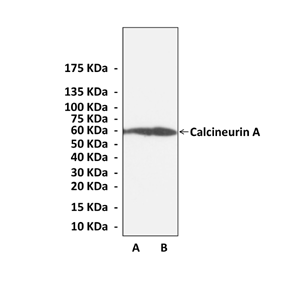Anti-Calcineurin A: Mouse Calcineurin A (PP2B-A) Antibody |
 |
BACKGROUND Protein Ser/Thr phosphatases are a group of enzymes that catalyze the removal of phosphate groups from serine and/or threonine residues by the hydrolysis of phosphoric acid monoesters. They directly oppose the actions of kinases and phosphorylases and therefore play an integral role in many signal transduction pathways. There are two groups of serine/threonine phosphatases; phosphoprotein phosphatases (e.g. PP1, calcineurin), which are sensitive to okadaic acid and metallo-phosphatases (e.g. PP2C), which require a divalent cation, commonly Mg2+, for catalytic activity. Dephosphorylation, depending on the residue that the phosphate group is removed from, can have a stimulatory or inhibitory effect on the target molecule. This makes protein Ser/Thr phosphatases essential for many signal transduction pathways. Protein Ser/Thr phosphatase are regulated by their subcellular localization and by inhibitor proteins, which are subtype-specific.1
PP2B (or calcineurin) is a serine/threonine phosphatase that exists as a heterodimer composed of a 58–64-kDa catalytic subunit (A subunit; PP2B-A) and a 19-kDa Ca2+ regulatory subunit (B subunit; PP2B-B). PP2B-A has three isoforms (a, b, and c); the a and b isoforms are ubiquitous, whereas the c isoform is testis-specific. PP2B is a Ca2+/CaM-activated enzyme involved in the regulation of a variety of cellular functions. PP2B-A contains an autoinhibitory (AI) domain and the binding sites for PP2B-B and CaM. In the absence of CaM, the AI domain binds to the active cleft of PP2B and inhibits the phosphatase activity. PP2B is activated upon the binding of Ca2+-calmodulin. It plays an essential role in T-cell activation through the NFAT signaling pathway, and it regulates the gene expression of Interleukin-2. FK506 and Cyclosporin A, when bound to their respective binding proteins, FKBP12 and Cyclophilin A, are specific inhibitors of PP2B.2 PP2B also regulates the cellular functions by binding to several proteins, including a kinase anchor protein family, PP2B inhibitor CAIN, Down Syndrome candidate region 1, and acute myeloid leukemia 1. PP2B has relatively narrower substrate specificity including transcription factors, e.g., NFAT, the transcription factor Elk1, and the Heat–Shock protein hsp25. These indicate that PP2B may play a role in the regulation of gene expression through the modification of transcription factors. In addition, it was shown that PMA stimulates the association of the PP2B/c-Jun/Sp1 complex with the promoter. The dephosphorylation of c-Jun C-terminus is required for the c-Jun/Sp1 interaction and PP2B plays an important role in regulating c-Jun/Sp1 interaction in PMA-induced gene expression.3
PP2B (or calcineurin) is a serine/threonine phosphatase that exists as a heterodimer composed of a 58–64-kDa catalytic subunit (A subunit; PP2B-A) and a 19-kDa Ca2+ regulatory subunit (B subunit; PP2B-B). PP2B-A has three isoforms (a, b, and c); the a and b isoforms are ubiquitous, whereas the c isoform is testis-specific. PP2B is a Ca2+/CaM-activated enzyme involved in the regulation of a variety of cellular functions. PP2B-A contains an autoinhibitory (AI) domain and the binding sites for PP2B-B and CaM. In the absence of CaM, the AI domain binds to the active cleft of PP2B and inhibits the phosphatase activity. PP2B is activated upon the binding of Ca2+-calmodulin. It plays an essential role in T-cell activation through the NFAT signaling pathway, and it regulates the gene expression of Interleukin-2. FK506 and Cyclosporin A, when bound to their respective binding proteins, FKBP12 and Cyclophilin A, are specific inhibitors of PP2B.2 PP2B also regulates the cellular functions by binding to several proteins, including a kinase anchor protein family, PP2B inhibitor CAIN, Down Syndrome candidate region 1, and acute myeloid leukemia 1. PP2B has relatively narrower substrate specificity including transcription factors, e.g., NFAT, the transcription factor Elk1, and the Heat–Shock protein hsp25. These indicate that PP2B may play a role in the regulation of gene expression through the modification of transcription factors. In addition, it was shown that PMA stimulates the association of the PP2B/c-Jun/Sp1 complex with the promoter. The dephosphorylation of c-Jun C-terminus is required for the c-Jun/Sp1 interaction and PP2B plays an important role in regulating c-Jun/Sp1 interaction in PMA-induced gene expression.3
REFERENCES
1. Gallego, M. & Virshup, D.M.: Curr. Opin. Cell Biol. 17:197-202, 2005
2. Blanchet, B. et al: Analyt. Biochem. 312:1-6, 2003
3. Chen, B-K. et al: Mol. Biol. Cell 18:1118-27, 2007
2. Blanchet, B. et al: Analyt. Biochem. 312:1-6, 2003
3. Chen, B-K. et al: Mol. Biol. Cell 18:1118-27, 2007
Products are for research use only. They are not intended for human, animal, or diagnostic applications.
Параметры
Cat.No.: | CA11008 |
Antigen: | Short peptide from human calcineurin/PP2B-A sequence. |
Isotype: | Mouse IgG |
Species & predicted species cross- reactivity ( ): | Human, Mouse, Rat |
Applications & Suggested starting dilutions:* | WB 1:1000 IP n/d IHC 1:50 - 1:200 ICC n/d FACS n/d |
Predicted Molecular Weight of protein: | 58-64 kDa |
Specificity/Sensitivity: | Detects endogenous levels of calcineurin/PP2B-A proteins without cross-reactivity with other related proteins. |
Storage: | Store at -20°C, 4°C for frequent use. Avoid repeated freeze-thaw cycles. |
*Optimal working dilutions must be determined by end user.
Документы
Информация представлена исключительно в ознакомительных целях и ни при каких условиях не является публичной офертой








